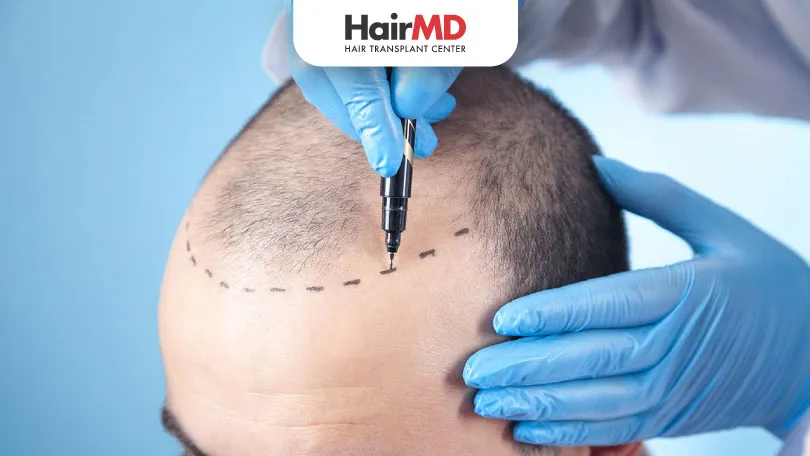25th April, 2022

Explore the different types of hair transplant treatments available, including FUE, FUT, and advanced techniques. Learn about their benefits, processes, and how to choose the best option for hair restoration.
Hair transplant treatments have evolved remarkably over the years, offering a variety of options to those seeking to restore their hairline and regain their confidence. From the traditional methods that laid the foundation for modern techniques to the advanced procedures that promise natural-looking results with minimal downtime, the world of hair transplantation is vast and continually advancing. This article delves into the different types of hair transplant treatments, highlighting the journey from classic techniques to the innovative solutions available today, helping you make an informed decision about which approach may be best suited for your needs.
What’s covered in the article?
- What is a Hair Transplant?
- Classic Techniques: Punch Grafts and Strip Harvesting
- Types of Hair Transplant Treatments in India
- Advance Hair Transplant Treatment
- Non-Surgical Hair Restoration Options
- How to Decide Which Surgery is Right for You?
- Undergo Safe Hair Transplant Procedures with HairMD
- Conclusion
What is a Hair Transplant?
A Hair Transplant Treatment involves moving hair from the back or side of the head to the front or top. In cases where there is no or thin hair present on the back or side of the head. The procedure is performed by an experienced and qualified dermatologist or dermatosurgeon. It aims to restore hair growth to areas of the scalp that suffer from limited or absolutely no hair growth. Let’s now see the different types of hair transplant procedures.
Classic Techniques: Punch Grafts and Strip Harvesting
The earliest forms of Hair Transplant Treatments involved the use of punch grafts, which consisted of small round sections of scalp tissue containing hair follicles.
These grafts were placed into tiny holes in the recipient area, creating a patchy look that was far from natural.
This technique was later improved with strip harvesting, where a long strip of scalp tissue containing hair follicles was removed from the back or sides of the head and transplanted onto areas with thinning or balding hair.
While this method produced better results than punch grafts, it still left visible scars on the donor area and required an extensive healing process.
Types of Hair Transplant Treatments in India
Follicular Unit Transplantation (FUT)
As hair transplantation continued to evolve, the focus shifted towards creating more natural-looking results with minimal scarring.
This led to the development of Follicular Unit Transplantation (FUT), also known as the strip method.
Instead of grafting a long strip of scalp tissue, FUT involves slicing the donor strip and harvesting individual units of naturally occurring groups of hair follicle and then transplanting them into tiny incisions made in the recipient area.
This precise technique resulted in more natural-looking hair growth and reduced scarring.
However, it still required an extensive healing process and was not suitable for those with limited donor areas.
Follicular Unit Extraction (FUE)
In recent years, Follicular Unit Extraction (FUE) has become the preferred method of hair transplantation treatment.
This technique involves harvesting individual follicular units directly from the scalp using a small punching tool, without the need for a linear incision or sutures.
These units are then transplanted into the recipient area, creating a natural-looking and seamless result with minimal scarring.
FUE is suitable for those with limited donor areas as it allows for targeted extraction of individual follicles from different parts of the scalp.
It also has a faster healing time compared to FUT since there is no need for stitches or staples.
Advance Hair Transplant Treatment
Robotic Hair Transplantation
Advancements in technology have also led to the development of robotic hair transplantation, which utilizes artificial intelligence and robotics to assist in the FUE process.
The robotic system can analyze and map out the patient’s scalp, identify the best donor areas, and extract and transplant follicular units with precision and speed.
This method has gained popularity due to its accuracy, efficiency, and minimal scarring.
Scalp Reduction
Scalp reduction is a surgical procedure used to treat baldness by removing areas of bald scalp and stretching the remaining hair-bearing scalp to cover the excised area.
This technique is often used in conjunction with other hair restoration methods, such as Follicular Unit Extraction (FUE) or Follicular Unit Transplantation (FUT), to achieve a more comprehensive and natural-looking result.
During the procedure, a portion of the bald scalp is excised, and the surrounding skin is loosened and pulled together, effectively reducing the bald area. Scalp reduction is typically recommended for individuals with extensive baldness and a good degree of scalp laxity, allowing for the necessary stretching of the remaining skin.
While scalp reduction can significantly reduce the bald area, it carries certain risks and limitations. Potential complications include scarring, infection, and changes in scalp sensation. Additionally, the results are highly dependent on the patient’s scalp elasticity and the extent of baldness.
Despite these challenges, scalp reduction can be a viable option for those seeking a more immediate and noticeable improvement in their hair coverage.
You should consult a qualified hair transplant specialist to determine if scalp reduction is the right approach for your specific needs and goals.
Direct Hair Implantation (DHI)
Direct Hair Implantation (DHI) is a minimally invasive hair restoration technique that has gained significant traction due to its precision and natural-looking results.
Unlike traditional methods, DHI utilises a specialised tool known as the Choi Implanter Pen, which enables the practitioner to simultaneously create the recipient site and implant the hair follicle, ensuring minimal handling of the grafts. This approach reduces the risk of follicle damage and increases the survival rate of transplanted hairs.
The DHI procedure begins with the extraction of hair follicles, typically from the back or sides of the scalp, using a fine, motorised instrument. These follicles are then immediately loaded into the implanter pen and inserted directly into the recipient area.
This efficient process allows for the precise placement of each hair follicle, giving the practitioner full control over the angle, direction, and depth of the implants. Consequently, DHI can deliver a more natural hairline and denser coverage.
One of the notable advantages of DHI is the reduced healing time compared to other hair transplantation methods. Patients typically experience less discomfort, minimal scarring, and a quicker return to normal activities. Furthermore, DHI is highly versatile and can be used for various types of hair loss, including scalp hair, beard, and eyebrow restoration.
Despite its many benefits, DHI is not without its limitations. The procedure can be time-consuming and is generally more expensive than other techniques due to the specialised equipment and expertise required.
Therefore, it is crucial for patients to have a thorough consultation with a qualified hair restoration expert to discuss their suitability for DHI and to understand the costs involved.
Flap Surgery
Flap surgery is a sophisticated technique employed in hair restoration that involves the transplantation of a large section of scalp tissue with hair from the donor area to the recipient site. This method is particularly useful for patients requiring significant coverage due to extensive hair loss.
The procedure typically starts with the surgeon lifting a segment of scalp tissue, often from the sides or back of the head, which maintains its blood supply through a connected ‘flap’.
The lifted tissue is then repositioned to the balding area, where it is secured with stitches. The advantage of flap surgery lies in its ability to cover large bald areas in a single session, thereby providing an immediate boost in hair density.
Additionally, because the transplanted tissue contains hair follicles that are generally resistant to balding, the results are often long-lasting and natural-looking.
However, flap surgery is not without its challenges. The procedure is more invasive than other hair restoration methods, necessitating a longer recovery period and posing a higher risk of complications such as infection, scarring, and blood flow issues to the transplanted tissue.
As a result, it is essential for patients to seek the expertise of a qualified surgeon and to have a detailed understanding of the potential risks and benefits before opting for flap surgery.
Non-Surgical Hair Restoration Options
Whey protein has become a cornerstone supplement for fitness enthusiasts and athletes alike, primarily due to its multifaceted benefits that align with various health and fitness goals. At its core, whey protein is celebrated for its exceptional amino acid profile, which is crucial for muscle growth and repair.
This makes it an invaluable asset for those looking to enhance muscle hypertrophy and accelerate recovery times after workouts. Beyond muscle development, whey protein provides a substantial energy boost, helping replenish energy reserves depleted during exercise, thereby optimizing post-workout recovery.
Additionally, whey protein plays a pivotal role in weight management. Its ability to promote feelings of fullness or satiety can significantly aid in reducing overall calorie intake, making it a strategic supplement for those aiming to lose weight without compromising muscle mass.
Furthermore, whey protein serves as an essential nutritional supplement, especially in diets lacking in adequate protein. Its convenience and efficiency in delivering high-quality protein help bridge dietary gaps, ensuring the body receives the necessary nutrients for optimal health and performance.
Collectively, these benefits underscore why whey protein is favored among a wide array of dietary supplements, marking it as a top choice for supporting an active and healthy lifestyle.
Now lets understand some basics about hair loss before we dive into the relation between whey protein and hair loss.
How to Decide Which Surgery is Right for You?
Choosing the right hair restoration surgery involves several important factors that need careful consideration. First, it’s crucial to assess the extent and pattern of your hair loss.
Some surgical options are better suited for specific types of balding, so understanding this can significantly narrow down your choices. Consulting with a Qualified Hair Transplant Surgeon can provide you with a clearer picture of which procedure is most appropriate for your condition.
Secondly, think about your lifestyle and the amount of downtime you can feasibly manage. Procedures like flap surgery and traditional hair transplants require a more extended recovery period and may not be viable options if you need to return to normal activities quickly.
Conversely, less invasive methods like follicular unit extraction (FUE) offer shorter recovery times, which may be preferable for those with busy schedules.
Another important factor is your budget. Hair restoration surgeries can be costly, and prices vary depending on the complexity of the procedure and the surgeon’s expertise. It’s essential to weigh the potential long-term benefits against the financial investment to ensure you make a decision that aligns with your economic situation.
Lastly, consider the outcomes you hope to achieve. Speak with your surgeon about your expectations and ensure they are realistic. Reviewing before-and-after photos of previous patients can also provide insight into what you can expect post-surgery.
Balancing these factors will help you make an informed decision tailored to your unique needs, ultimately guiding you towards the most suitable hair restoration surgical option.
Undergo Safe Hair Transplant Procedures with HairMD
HairMD is a team of Qualified Dermatologists with experience with several successful hair transplant surgeries to its credit. We offer FUE hair transplant treatment that requires a more meticulous surgical approach and a higher degree of expertise. know more about our treatment and the results we’ve delivered through our hair transplant surgeries.
For Hair loss consultation appointments, connect with the Hair Transplant Center in Pune
Do You Know?
Nearly 250 Patients Visit HairMD
Everyday For Various Hair Concerns?
(Your journey to healthier and fuller hair starts here!)
Meet Our Dermatologists
Conclusion
In conclusion, selecting the right hair restoration surgical option requires careful consideration of various factors including the type and pattern of hair loss, lifestyle constraints, budget, and desired outcomes. By consulting with a qualified surgeon and conducting thorough research, you can make a well-informed decision that best suits your individual needs.
If you’re ready to take the next step towards reclaiming your hair and confidence, we encourage you to schedule a consultation with our expert hair transplant surgeons today. Our specialists are here to guide you through every step of the process, ensuring you achieve the results you desire.
Don’t wait—take action now and start your journey towards a fuller, healthier head of hair.
Further Reading
Top Kitchen Ingredients to Boost Hair Growth
Discover the best kitchen ingredients for hair growth! Use coconut oil, onion juice, aloe vera & more to nourish your hair naturally and reduce hair fall.
How to Treat Alopecia Areata at Home: Natural Solutions for Hair Growth
Explore home remedies for alopecia areata to promote hair regrowth and boost confidence from home.
Redensyl vs. Minoxidil: Which is the Better For Hair Growth?
Discover the differences between Redensyl and Minoxidil for hair growth. Learn about their effectiveness, side effects, and which treatment might be better for you.
Biotin-Rich Foods for Natural Hair Growth
Know the best foods rich in biotin to help your hair to grow naturally stronger and healthier by experts from HairMD, Pune
Have thoughts? Please let us know
We are committed not only to treating you, but also educating you.











